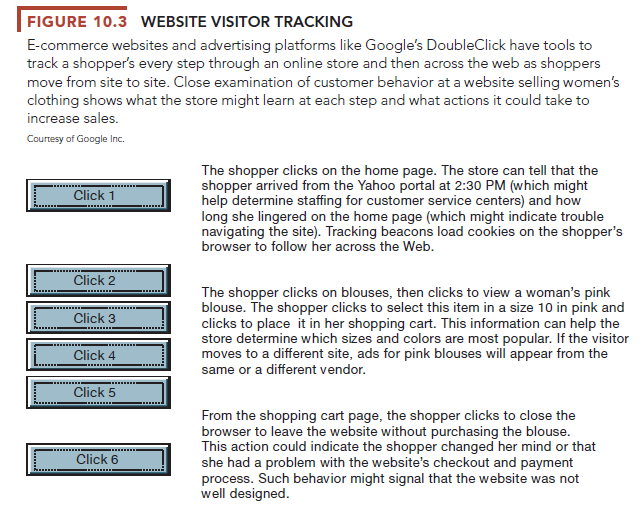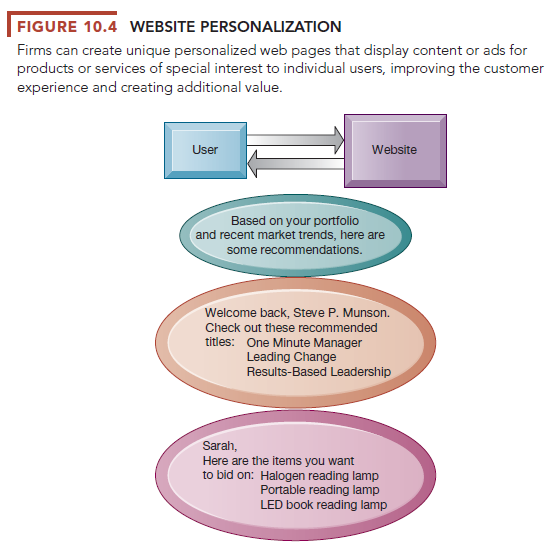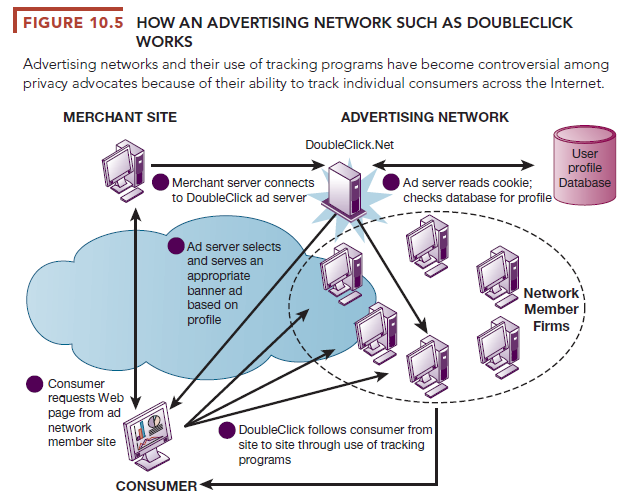Many e-commerce marketing firms use behavioral targeting techniques to increase the effectiveness of banners, rich media, and video ads. Behavioral targeting refers to tracking the clickstreams (history of clicking behavior) of individuals on thousands of websites to understand their interests and intentions and expose them to advertisements that are uniquely suited to their online behavior. Marketers and most researchers believe this more precise understanding of the customer leads to more efficient marketing (the firm pays for ads only to those shoppers who are most interested in their products) and larger sales and revenues. Unfortunately, behavioral targeting of millions of web users also leads to the invasion of personal privacy without user consent. When consumers lose trust in their web experience, they tend not to purchase anything. Backlash is growing against the aggressive uses of personal information as consumers seek out safer havens for purchasing and messaging. Snapchat offers disappearing messages, and even Facebook has retreated by making its default for new posts “for friends only.”

Behavioral targeting takes place at two levels: at individual websites or from within apps and on various advertising networks that track users across thousands of websites. All websites collect data on visitor browser activity and store it in a database. They have tools to record the site that users visited prior to coming to the website, where these users go when they leave that site, the type of operating system they use, browser information, and even some location data. They also record the specific pages visited on the particular site, the time spent on each page of the site, the types of pages visited, and what the visitors purchased (see Figure 10.3). Firms analyze this information about customer interests and behavior to develop precise profiles of existing and potential customers. In addition, most major websites have hundreds of tracking programs on their home pages, which track your clickstream behavior across the web by following you from site to site and re-target ads to you by showing you the same ads on different sites. The leading online advertising network is Google’s DoubleClick.
This information enables firms to understand how well their website is working, create unique personalized web pages that display content or ads for products or services of special interest to each user, improve the customer’s experience, and create additional value through a better understanding of the shopper (see Figure 10.4). By using personalization technology to modify the web pages presented to each customer, marketers achieve some of the benefits of using individual salespeople at dramatically lower costs. For instance, General Motors will show a Chevrolet banner ad to women emphasizing safety and utility, whereas men will receive ads emphasizing power and ruggedness.

It’s a short step from ad networks to programmatic ad buying. Ad networks create real-time bidding platforms (RTB) where marketers bid in an automated environment for highly targeted slots available from web publishers. Here, ad platforms can predict how many targeted individuals will view the ads, and ad buyers can estimate how much this exposure is worth to them.
What if you are a large national advertising company or global manufacturer trying to reach millions of consumers? With millions of websites, working with each one would be impractical. Advertising networks solve this problem by creating a network of several thousand of the most popular websites millions of people visit, tracking the behavior of these users across the entire network, building profiles of each user, and then selling these profiles to advertisers in a real-time bidding environment. Popular websites download dozens of web-tracking cookies, bugs, and beacons, which report user online behavior to remote servers without the users’ knowledge. Looking for young, single consumers with college degrees, living in the Northeast, in the 18-34 age range who are interested in purchasing a European car? Advertising networks can identify and deliver thousands of people who fit this profile and expose them to ads for European cars as they move from one website to another. Estimates vary, but behaviorally targeted ads are generally 10 times more likely to produce a consumer response than a randomly chosen banner or video ad (see Figure 10.5). So-called advertising exchanges use this same technology to auction access to people with very specific profiles to advertisers in a few milliseconds. In 2016, about 50 percent of online display ads were targeted ads developed by programmatic ad buys, and the rest depended on the context of the pages shoppers visited—the estimated demographics of visitors, or so-called blast-and-scatter advertising—which is placed randomly on any available page with minimal targeting, such as time of day or season.

It’s another short step to native advertising. Native advertising involves placing ads in social network newsfeeds or within traditional editorial content, such as a newspaper article. This is also referred to as organic advertising, where content and advertising are in very close proximity or integrated together.
Two-thirds (68 percent) of Internet users disapprove of search engines and websites tracking their online behavior to aim targeted ads at them. Twenty-eight percent of those surveyed approve of behavioral targeting because they believe it produces more relevant ads and information. A majority of Americans want a Do Not Track option in browsers that will stop websites from collecting information about their online behavior. More than 50 percent are very concerned about the wealth of personal data online; 86 percent have taken steps to mask their online behavior; 25 percent of web users use ad- blocking software (Rainie, 2016).
Source: Laudon Kenneth C., Laudon Jane Price (2020), Management Information Systems: Managing the Digital Firm, Pearson; 16th edition.

I do agree with all of the ideas you’ve presented in your post. They’re very convincing and will certainly work. Still, the posts are very short for beginners. Could you please extend them a bit from next time? Thanks for the post.
I got good info from your blog